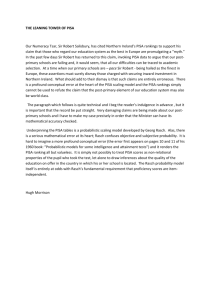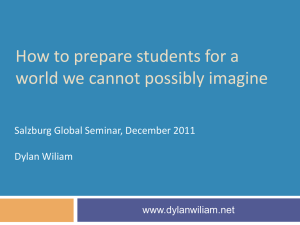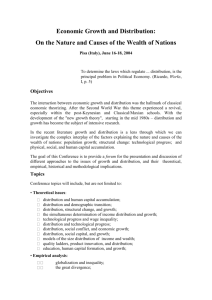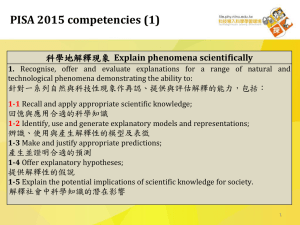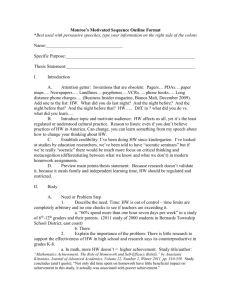Transfer reactions from bound to unbound states
advertisement
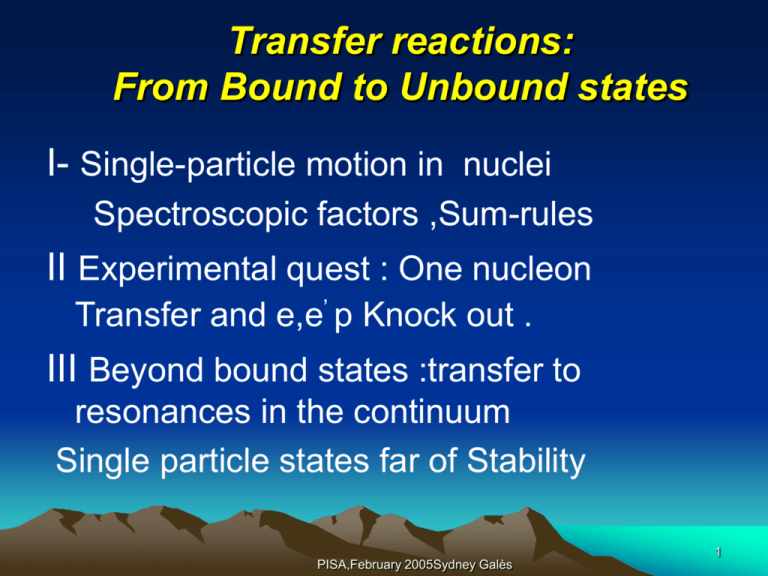
Transfer reactions: From Bound to Unbound states I- Single-particle motion in nuclei Spectroscopic factors ,Sum-rules II Experimental quest : One nucleon Transfer and e,e’ p Knock out . III Beyond bound states :transfer to resonances in the continuum Single particle states far of Stability 1 PISA,February 2005Sydney Galès Nucleon-Nucleus mean field °Mean field concept similar for bound (shell model ) and scattering (optical model) states. °°In real nuclei the mean field is non-local. V(r,r ’) velocity dependence Fluctuations of V give rise to collective modes . Coupling of s-p motion to Collective modes leads to V(r,r’,E). °°°Local equivalent V(r,E)=VHF (r,E)+ DV(r,E) Dynamical content of IPM Potential depth A independent 2 PISA,February 2005Sydney Galès Long Range Correlations Coupling to (1p-1h) ,…, (np-nh) na 1 IPM Ef E na 1 IPM+Corr Ef E Depletion of the fermi sea 15% 3 PISA,February 2005Sydney Galès Proton Stripping reaction Single-particle states 208Pb+1p Above 2.5 MeV strong fragmentation of Single –particle strengths !!! 4 PISA,February 2005Sydney Galès Spectroscopic Factors & sum-rule Pick-up S-lj(A,A-1)= /<Ff(A-1)/alj /F0(A)>/2 Stripping S+lj(A,A+1)= /<Ff(A+1)/a+lj /F0(A)>/2 Sum-Rule Sum of Slj on all final sates f with lj quantum numbers give Sf Slj = < F0(A)/ a+a/ F0(A)>= nlj number of nucleons lj in the ground state Two obvious problems in deducing absolute values for this sum-rule Sum of all final fragments limited in Energy short range correlations (up to high Ex) Accuracy of reaction models Cross-sections dependence on form factors , Optical parameters 5 PISA,February 2005Sydney Galès Reaction model for one-nucleon transfer • DWBA A+a • TBA= B+b b=a+/-1n one-step draA drbB C b-* (kb,rbB) F(raA ,r bB) C a+ (ka,raA) OM elas channels • EFR-DWBA ds/dwEXP (q) = C2Slj. K. [ TBA]2= C2S ds/dw EFR-DW (q) . F contains 1) the Vnb interaction between the ejectile b and the transferred nucleon n (from n-n or n-b phase shifts at low energies) Zero Range Vnb= Do d(rbn)dl0 2) the form factor flj(r) . Calculated in WS potential ,to reproduce correct binding (SE, energy dependence) . ds/dwDW (q) displays strong dependence on the radius 6 PISA,February 2005Sydney Galès Bound states and polarized beams in transfer State of the art :OSAKA 1993 2p3/2 2p1/2 P=80% 30KeV 7 PISA,February 2005Sydney Galès Examples : Angular distributions and asymmetries 2p3/2 ,2p1/2 in 49Ca L=1 J=3/2 L=1 J=1/2 8 PISA,February 2005Sydney Galès From stripping and pick-up :occupation numbers and shell closure Excellent closure of f7/2 >95% Open sd shell 15-25% 9 PISA,February 2005Sydney Galès (e,e’,p) State of the art 10 PISA,February 2005Sydney Galès LRC and SRC 11 PISA,February 2005Sydney Galès Persistence of s-p motion at high excitation energy ? First evidence of deeply-bound hole states in heavy nuclei 12 PISA,February 2005Sydney Galès Spin of deep-hole states 1g9/2neutron-hole in 120Sn GR like structure (1-2MeV) Broad peak 1MeV IUCF 1980 9/2+ 7/2 + 13 PISA,February 2005Sydney Galès Selectivity for large L transfer (5-8) Direct observation of Spin-orbit partners 14 PISA,February 2005Sydney Galès Transfer to Unbound states Standard DWBA • Unbound state Form Factor • Gamov function pole of the Green s-p wave function • gRlj(r,kr) =( mGlj /h2kr) eixlj Olj Solution of Schrodinger equation for the complex energy ERes= ER –i G/2 15 PISA,February 2005Sydney Galès Damping Mechanism G =2P<V>2r =2<W> 16 PISA,February 2005Sydney Galès Experimental observation of the damping steps (1p-1h) to (np-nh) 17 PISA,February 2005Sydney Galès Single-particle motion far of stability John Elbfas, 1535, Storkyrkan, Stockholm 1p splitting , 8He,12-14Be,20C,22O Mainly Pol (p,d) and (d,p) 18 PISA,February 2005Sydney Galès Structure of 11Be g.s. through (p,d) reaction Beg.s. =S1/2(0+ )10Be0+2s +S1/2(2+ )10Be2+1d +..... H(11Be,10Be)2H E = 35 A.MeV 11 4 (ds/dW)exp=S(ds/dW)calc S(2+) = 0.2 S(2+) + S(0+) 10Be (coinc with 2H) 0.4o qlab 1.2o S. Fortier et al. PLB 461 (1999) 22 J.S. Winfield et al. NPA 683 (2001) 48 19 PISA,February 2005Sydney Galès Structure of 10Li G. S via transfer reactions 105 11Be /s S.Pita PhD thesis Orsay,2000 20 PISA,February 2005Sydney Galès Structural changes with neutron excess Diffuse Nuclear Surface Leads to vanishing Spin-orbit splitting New « magic numbers » Test cases N=20, 1d splitting 28,30Ne,32Mg,34Si Z=20 N=28-40 46Ar Z=28 N=28-40,1f 56Ni,68Ni N=50-82,1g,2d 116-134Sn 21 PISA,February 2005Sydney Galès > 1013 fiss./s Low energy RNB Production Cave C converter+UCx target CIME Cyclotron RNB (fission-fragments) E < 6-7 MeV/u,132Sn 109pps SC - LINAC E = 14.5 AMeV HI A/Q=3 E = 40 MeV - 2H “SILHI-deuteron” 5mA ECRIS-HI 1mA RFQ - 0.75A MeV Regions of the Chart of Nuclei Accesible with SPIRAL 2 beams Primary beams: deuterons heavy ions 6. SHE 4. N=Z Isol+In-flight 5. Transfermiums In-flight 2. Fusion reaction with n-rich beams 1. Fission products (with converter) 3. Fission products (without converter) 8. Deep Inelastic Reactions with RNB 7. High Intensity Light RIB NuPPEC Roadmap for the European Strategic Forum for Research Infrastructures (March 2005) NuPECC recommends the construction of 2 ‘next generation’ RIB infrastructures in Europe, i.e. one ISOL and one in-flight facility. The in-flight machine would arise from a major upgrade of the current GSI facility. Among the intermediate steps on the road to “the EU Isol facility” EURISOL (2014) ,SPIRALII has a clear EU dimension in terms of size,investment(130M€) and site (GANIL). Latest News To build strong collaboations within European low energy communities for both stable and RIB,,GANIL and Legnaro are in the way to establish a new European laboratory ,open to all french and italian communities and later to others. Loi are presently submitted to a steering committee and a workshop is being prepared (April 8&9 ,Legnaro ) where the scientifc goals of this new initiative will be discussed 24 PISA,February 2005Sydney Galès **Conclusions • • • • • Absolute spectroscopic factors for strong s-p bound valence states with are within reach ,combining careful analysis from nucleon transfer and electron knock-out with an accuracy of (10% at best) But s-p have partial occupation ,rest of the strength at very high( Ex>100 MeV) outside shell model space SM describes only 70% of nucleons due to SRC (15%) and LRC (15%) Highly fragmented sp strengths, in particular for unbound resonances embedded in the continuum suffer greatly from the use of inadequate « standard » parameters (E dependence of form factors , continuum) . Form factors from HF-RPA or QPM models may improve the accuracy. For exotic nuclei coupling to continuum occurs even more rapidly as a function of Ex . Careful analysis of deduced SF needed to establish for exemple SPIN-ORBIT SPLITTING Nuclear Knock-out seems promising, in particular for “exotic” nuclei,careful evaluation of the reaction model parameters and various kinematics ,and target conditions are certainly needed to assess the potential of this approach. 25 PISA,February 2005Sydney Galès END 26 PISA,February 2005Sydney Galès Neutron rich C & O isotopes 27 PISA,February 2005Sydney Galès Isopin dependence of spin-orbit interaction The Spin-orbit interaction is proportional to the nuclear distribution in a stable nucleus. In an unstable nucleus, the differential of the proton and the neutron distribution have peaks at different distances, therefore isospin dependence of the spinorbit interaction becomes important 28 PISA,February 2005Sydney Galès Spin-Orbit Splitting eso=aso l.s. dr/dr=1/2(2L+1) x x=<1/V.dV/dr>=g(A) .f(n) • • Nucleus • 12C • 16O • 40Ca • 48Ca 90Zr protons nl eso 1p 8.24 1p 6.88 1d 6.7 1f 6.3 1h 2f 5.8 1.7 140Ce 208Pb neutrons nl eso 1p 8.5 1p 6.7 1d 6.7 2p 2.1 1f 8.9 2p 1.9 1g 7.9 2p 1.1 2d 2.4 1h 6.5 2d 1.7 1i 6.4 2f 1.8 G.Mairle Phys.lett B 1993 29 PISA,February 2005Sydney Galès Neutron Transfer on 132Sn EXOGAM g p 132Sn 15A.MeV D Determine neutron-captures at stellar temperatures Spectroscopic factors CN Sn=2.7 MeV 133Sn 9/2-1/2 3/27/2- 132Sn DC Statistical models not valid at magic shells - Direct capture component - Compound nucleus component 133Sn 30 PISA,February 2005Sydney Galès 4p particle + 20% g (EXOGAM) W N CATFORD DE:500 keV TIARA DE:50 keV 68+nNi E* ; Lp ; S Bound States University of Surrey TIARA is designed to be used with EXOGAM and VAMOS at GANILPISA,February 2005Sydney Galès DARESBURY 31 Absolute Spectroscopic factors from Nuclear knock-out reactions Brown,Hansen,Sherill,Tostevin • • One nucleon removal partial cross-sections to final identified (nlj) bound states have been measured for about 25 nuclei in sd shell and on 12C and 16O Theoretical s-p removal cross-sections sth(nlj) has been calculated using shell model predictions for the s-f and eikonal reaction theory R= sexp/s th • sth(nlj)= Sj Snlj ssp(Bn,lj) ssp(Bn,lj) calculated from a define set of parameters S-Matrix from free nn np cross-sections, d interaction or Gaussian range functions n-core w-f calculated with empirical W-S (r,a) standard set Outcome R=1 for l=0 and 2 transitions for 25-27Si, 10,11 Be, 14-18C R=0.5-0.6 for n and p hole in12C and 16O g.s .Strong quenching like in e,e’ p !! How we understand that ? How it compares to p,2p knock out ? 32 PISA,February 2005Sydney Galès Persistence of s-p motion at high excitation energy ? Inclusive single -particle spectra Strength functions for resonance in the continuum Exclusive experiments and decay properties. 33 PISA,February 2005Sydney Galès S-P response function: Exp versus QPM 34 PISA,February 2005Sydney Galès Single Particle states - 1970 Early experimental evidences Light-Nuclei :Well separated shells Broad inner 1s shell Medium and heavy nuclei Rapidly overlapping 35 shells PISA,February 2005Sydney Galès Energy dependence of the damping width for s-p response function 36 PISA,February 2005Sydney Galès Single –Particle strenghts from IAS 37 PISA,February 2005Sydney Galès Transfer to continuum and reaction model Bonnacorso,Brink 38 PISA,February 2005Sydney Galès Decay of single-particle states 39 PISA,February 2005Sydney Galès Gamma-decay of overlapping sub shells in 111Sn 40 PISA,February 2005Sydney Galès Damping of deep-hole in 208Pb Experiment and HF+RPA Model 41 PISA,February 2005Sydney Galès Nuclear Models: Damping Mechanisms Mass ,Energy Dependence of S(E),G • A) HF+RPA N. Van Giai et al Pb Bertsch, Broglia, Bortignon Sn, Pb self-consistent or effective coupling B) Mean field + Dispersion Relation C. Mahaux et al 40Ca to 208Pb Empirical –Optical potential W-S .All coupling included C) Semi-classical description Brink & Bonnacorso, n-N optical model D) Quasiparticle-Phonon Model V.G.Soloviev,Ch.Stoyanov,A.I.Vdovin,V.Voronov et al From Zr to Pb H= Hsp+Hpair+ Hmultipole+Hspin-multipole WS Monopole Multipole spin-multipole part-part part-hole part-hole Large basis s-p ,phonons (up to 25 MeV,l>5) 42 PISA,February 2005Sydney Galès Comparison of Hadronic and electromagnetic processes 43 PISA,February 2005Sydney Galès Quenching of S-P strengths Summary 1 A) For bound states close the Fermi sea e,e’p observed a severe quenching (50+/-10%) not observed in transfer reactions (90+-15%) B) One can reconcile partly e,e’p and transfer reactions values using the radius determined in knock out experiments , 12C,16O,40Ca,90Zr,208Pb ( 70+/-15%) Two questions remains : How realistic is the use of this radius ? (pm shift in ang. dist) Is there hidden inconsistencies in the analysis of e,e’p Renormalization of quasi-elastic Coulomb coupling sep* If sep up by 10% n increases from 50 to 70% PISA,February 2005Sydney Galès 44 Fragmentation and damping of S-P strengths for valence and deeplybound states in e,e’p 45 PISA,February 2005Sydney Galès 46 PISA,February 2005Sydney Galès 47 PISA,February 2005Sydney Galès Proton knock-out process: (e, e ‘,p) 48 PISA,February 2005Sydney Galès Advantages and limitations (e,e’p) versus Transfer 49 PISA,February 2005Sydney Galès 50 PISA,February 2005Sydney Galès
